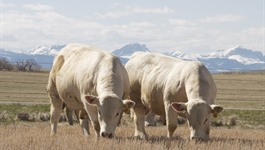DeBruycker Charolais Chosen as #10 in Top 100 Seedstock Operator
Fri 26 Feb, 2016
DeBruycker Charolais strive for balance first and last and has been chosen as #10 in Top 100 Seedstock Operator.
“Number one, we’re trying to make 2,000 cows that are all the same – same teats and udder structure, same leg structure, same body type, same calving ease,” explains Brett DeBruycker of DeBruycker Charolais at Dutton, Mont. “We want to make it so that our customers can’t see any differences between the first bull in our sale and the 550th bull.”

“We’ve never based our herd off of EPDs, ultrasound measurements or any of those things. We’ve always focused on the quality of the cow, the cow type, believing that type of cow would yield the right type of bull for our customers,” DeBruycker explains. “We’ve never selected for a single trait. We make sure it’s the right type of cow for the environment. We work very hard to keep them balanced.”
Though not the only focus, their single-minded focus on balance and their innate sense of cow type that works for them and their customers means they do have breed leaders by all sorts of measures.
“We focus on the animal. If the numbers follow, that’s fine. If they don’t, that’s fine, too,” DeBruycker emphasizes. “Our whole goal with the Charolais program, from the beginning, has been to do our best to make bulls and genetics that will go out and help the commercial rancher be profitable. Our attitude is that if our commercial customers are profitable, then we’ll be profitable.”
That’s how Brett’s dad and mom, Lloyd and Jane, started. They bought their first Charolais bull in the late 1950s to crossbreed their commercial cows. In 1963, they established the foundation for their purebred herd with some percentage heifers and artificial insemination (AI).
“We’re basically a line-bred herd but we aren’t afraid to bring in genetics from two or three outside bulls to sample every year,” Brett explains.
The DeBruyckers breed cows mostly through natural service. Heifer are bred in an intensive 35-day AI breeding program.
“We’re doing our best to help those fertile females get bred as early as possible,” Brett says.
Along with earlier calving, increased pounds at weaning and feedlot advantages, Brett says, “In our opinion, early maturity is what helps our cattle marble as well as they do.” It’s common for their purebred Charolais calves to be 85% Choice and 85% Yield Grade 1-2.
“The feedlot helps us keep our focus on genetics that work in each sector,” Brett says. Lloyd was part owner and manager of a feedlot from the ’70s through the ’90s. These days, Lloyd, Brett and Brett’s brother, Mark, partner on and feed about 25,000 customer calves each year.
“We are completely a family operation. We have a great love and respect for one another,” Brett explains.
Along with his dad and brother, Brett’s sisters Jacque and Cathy and their families are involved in the day-to-day operation.
Sisters Jody and Kelly and their families farm and ranch on their own. Another sister, Tammy, is an accounting professor in Washington. All return to help out when they can.
All agree about how customers should be treated.
“Our word is our bond,” DeBruycker says. “Our customers expect integrity and to be treated fairly, no matter what the situation is.”
The DeBruycker crew also agrees on what they’re trying to produce.
“We’ve had some high-selling bulls. We’ve also been fortunate that others have used our genetics and had success in the show ring but none of that has ever been a focus of ours,” Brett explains. “We want cattle that breed early, calve easily and grow quickly on milk and grass. Those same genetics carry into the calf. Those calves will go to the feedlot and packer and do very well there.“
For more information, visit BEEF